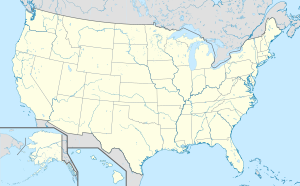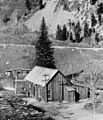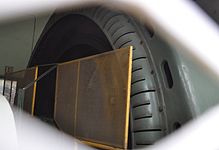Ames Hydroelectric Generating Plant
| Ames Hydroelectric Generating Plant | |||
|---|---|---|---|
| Ames Hydroelectric Generating Plant in 2011 | |||
| location | |||
|
|
|||
| Coordinates | 37 ° 51 '53 " N , 107 ° 52' 55" W | ||
| country | United States | ||
| Waters | Trout Lake , Howard Fork | ||
| Data | |||
| Type | Storage power plant | ||
| Primary energy | Hydropower | ||
| power | 3.75 MW | ||
| operator | Xcel Energy | ||
| Project start | 1890 | ||
| Start of operations | Spring 1891 | ||
| turbine | 2 × Pelton turbines | ||
| Website | Xcel Energy | ||
The hydropower plant Ames (English: Ames Hydroelectric Generating Plant ) is a hydroelectric power plant at Ophir in San Miguel County in the state of Colorado in the United States . It is considered to be the oldest commercially used hydropower plant that generated alternating current to drive machines and is listed on the IEEE list of milestones in the development of electrical engineering .
history
The gold mines in the area of Telluride (Colorado) were on the verge of collapse at the end of the 19th century because an end to inexpensive steam propulsion was in sight. The forests in the whole area were almost completely cleared and the wood was used either for the construction of the pit or as fuel for the boilers of the steam engines . Other fuels such as coal could not be supplied because there was no efficient railroad leading into the mountainous region, which is over 2600 meters high. LL Nunn , an entrepreneur who had immigrated from the east coast and was a major shareholder in the Gold King Mine , was looking for ways out of the situation. When looking for a new energy source, hydropower came into question, but the energy had to be transferred from a suitable location of a power plant over a distance of several kilometers to the mine in Telluride. The techniques known at the time for transmitting energy over great distances were direct current lines, cable transmissions or compressed air lines , such as those used in Paris to drive machines. None of these techniques were suitable for the intended application due to the high transmission losses.
Nunn learned about the new AC technology from his brother, who lived on the east coast of the United States. The Nunn brothers then asked George Westinghouse of Westinghouse Electric to supply the technology and equipment for the power plant. Westinghouse agreed because he saw a chance to win the electricity war .
In the summer of 1890 the generator for the power station and the engine for the mine were delivered. The plant went into operation in June 1891, so that the electricity company founded by the Nunn brothers under the name Telluride Power Company was able to sell its electricity to the Gold King Mine for the first time.
The success of the plant decided the current war in favor of alternating current and paved the way for the implementation of the first large power plant using alternating current technology: The Edward Dean Adams Power Plant , located near Niagara Falls , began operations in 1895, with one of the Nunn brothers providing advice during the construction.
The power plant was supplemented with further machine groups as early as 1892, so that other pits could also be supplied with electricity. In 1896 the system was converted to the 60 Hz system developed by Nikola Tesla , and in 1906 today's machine group was installed. In 1911 the Telluride Power Company was already operating eight power plants and had a transmission network of 1,000 km in length. The Ames Hydroelectric Generating Plant has changed hands several times and has been owned by Xcel Energy since 1999 .
Significance in the history of electrical energy supply
The Ames power plant is the oldest hydroelectric power plant that generates alternating current for industrial purposes, i.e. to drive machines. Although it was able to transmit over a longer distance, it did not initially use transformers because the energy was used to drive high-powered machines.
The first alternating current network with different voltage levels was put into operation in the United States five years earlier . It was located in the Great Barrington , Massachusetts resort town and began operating on March 20, 1886. The generator was powered by a steam engine.
The Thorenberg power plant , which went into operation in May 1886, is considered the world's first hydropower plant to be fed into an alternating current distribution network with two different voltage levels.
technology
1891-1905
The machine set from 1891 consisted of a Pelton turbine with a diameter of 1.8 meters, which was connected via a belt drive to an overcompensated double-ended synchronous generator ( salient pole machine ) with an output of 100 hp. The water was taken from Trout Lake, which was dammed up with a dam made of wood and stones , and passed through a wooden channel to a storage tank. From there it reached the machine house , which was initially just a pile of wood, via a single pressure pipe . The height of fall was 320 ft (97.5 m).
The single-phase alternating current generated had a frequency of 166 Hz and a voltage of 3000 V. It was carried over a 4.2 kilometer long overhead line to the Gold King Mine, where the current drove a motor that was identical to the generator in the power plant with the difference that the motor had a shunt winding.
The synchronous motor could not start by itself and therefore had to be started by a small asynchronous motor. For this purpose, the two motors were connected to a transmission via belts , the size of which was chosen so that the starter motor accelerated the synchronous motor beyond its synchronous speed when it reached its nominal speed. Once this stable speed was reached, the excitation of the synchronous motor could be switched on so that it ran as a self-excited generator. The asynchronous motor was then switched off and the speed of the machine group began to drop. At the moment when the speed and phase position matched the network of the generator, the synchronous motor was connected to the network, the starting motor was decoupled and the load was coupled to the synchronous motor. Once connected to the grid, the motor could cope with sudden large loads without any problems. The synchronization with the network was done manually by observing a synchroscope .
The line consisted of two wires with a diameter of 5.8 mm, which were run on wooden telegraph poles. The cost of the wires was only $ 700, which was only about 1% of the cost of direct current transmission. The plant did not use transformers.
As early as 1892, the power plant was expanded with a 600-horsepower generator that powered a 600-horsepower engine in the Bear Creek Mine at a distance of 16 km. Later that year, a 50-horsepower and a 75-horsepower engine were added in the Savage Basin mines, 14 miles away. From 1895, a 100 hp engine was operated in the Pandora mine, also 22.5 km away.
In 1869 the power plant was converted to the two-phase alternating current with a frequency of 60 Hz developed by Nikola Tesla .
First machine house of the power plant
From 1905
In 1905 the power plant was adapted to the steadily growing demand for electrical energy. Today's machine set was installed. To increase production in the winter months, an additional dam was built above Trout Lake and Lake Hope was dammed. The reservoir has a volume of 2.8 million m³ and an area of 18 hectares. Its water will be fed to Trout Lake via an underground tunnel from late autumn. In addition, the Howard's Fork was dammed with a dam. The water from this dam reaches the machine house via its own pressure pipe, where it is processed by its own Pelton wheel, which sits on the same shaft as the Pelton turbine that processes the water from Trout Lake.
In 1909, the Trout Lake dam failed after a flood, so it had to be replaced by an earth dam and was enlarged in the process. The lake has a volume of 3.9 million m³ whereby only 3.1 million m³ can actually be used. The surface is 56 hectares, the target is 2960 meters above sea level.
In the 1950s, the old wooden structure of the overflow was replaced by a steel structure.
In the 1980s, the power plant was converted to fully automatic operation and monitoring of the reservoir was expanded. In 1997 the voltage on the transmission line was increased from 69 kV to 115 kV.
See also
Web links
- Harry Matthews: Hydro Power Plant at Ames, Colorado (English)
Individual evidence
- ↑ Ames Hydro Generating Station. Xcel Energy , accessed October 26, 2013 .
- ^ A b Ames Hydro: Making History Since 1891. In: HydroWorld.com. August 27, 2013, accessed October 27, 2013 .
- ^ A b c d William Cawthorne Unwin: On the development and transmission of power from central stations . London and New York, Longmans, Green, 1894, Transmission of Power at the Gold King Mine, Telluride, Colorado, pp. 295 ( archive.org ).
- ↑ Western Slope plans electrified industry. Denver Post Four Corners Bureau, accessed October 27, 2013 .
- ↑ Paul Gromosiak, Christopher Stoianoff: Niagara Falls: 1850-2000 . Arcadia Publishing, 2012, ISBN 978-0-7385-7695-4 , pp. 85-.
- ↑ Milestones: Adams Hydroelectric Generating Plant, 1895. IEEE Global History Network, accessed December 29, 2013 .
- ↑ Western Slope plans electrified industry. (No longer available online.) Archived from the original on December 16, 2012 ; accessed on December 29, 2013 . Info: The archive link was inserted automatically and has not yet been checked. Please check the original and archive link according to the instructions and then remove this notice.
- ^ Milestones: Ames Hydroelectric Generating Plant, 1891. In: IEEE Global History Network. Retrieved October 21, 2013 .
- ^ Milestones: Alternating Current Electrification, 1886. In: IEEE Global History Network. October 2, 2004, accessed October 21, 2013 .
- ↑ a b Ames Hydroelectric Project Description. Xcel Energy, 2008, accessed November 4, 2013 .






